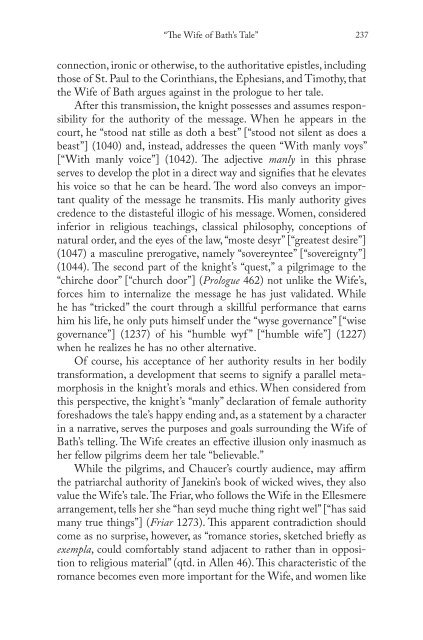Blooms Literary Themes - THE TRICKSTER.pdf - ymerleksi - home
Blooms Literary Themes - THE TRICKSTER.pdf - ymerleksi - home
Blooms Literary Themes - THE TRICKSTER.pdf - ymerleksi - home
You also want an ePaper? Increase the reach of your titles
YUMPU automatically turns print PDFs into web optimized ePapers that Google loves.
“Th e Wife of Bath’s Tale” 237<br />
connection, ironic or otherwise, to the authoritative epistles, including<br />
those of St. Paul to the Corinthians, the Ephesians, and Timothy, that<br />
the Wife of Bath argues against in the prologue to her tale.<br />
After this transmission, the knight possesses and assumes responsibility<br />
for the authority of the message. When he appears in the<br />
court, he “stood nat stille as doth a best” [“stood not silent as does a<br />
beast”] (1040) and, instead, addresses the queen “With manly voys”<br />
[“With manly voice”] (1042). Th e adjective manly in this phrase<br />
serves to develop the plot in a direct way and signifi es that he elevates<br />
his voice so that he can be heard. Th e word also conveys an important<br />
quality of the message he transmits. His manly authority gives<br />
credence to the distasteful illogic of his message. Women, considered<br />
inferior in religious teachings, classical philosophy, conceptions of<br />
natural order, and the eyes of the law, “moste desyr” [“greatest desire”]<br />
(1047) a masculine prerogative, namely “sovereyntee” [“sovereignty”]<br />
(1044). Th e second part of the knight’s “quest,” a pilgrimage to the<br />
“chirche door” [“church door”] (Prologue 462) not unlike the Wife’s,<br />
forces him to internalize the message he has just validated. While<br />
he has “tricked” the court through a skillful performance that earns<br />
him his life, he only puts himself under the “wyse governance” [“wise<br />
governance”] (1237) of his “humble wyf ” [“humble wife”] (1227)<br />
when he realizes he has no other alternative.<br />
Of course, his acceptance of her authority results in her bodily<br />
transformation, a development that seems to signify a parallel metamorphosis<br />
in the knight’s morals and ethics. When considered from<br />
this perspective, the knight’s “manly” declaration of female authority<br />
foreshadows the tale’s happy ending and, as a statement by a character<br />
in a narrative, serves the purposes and goals surrounding the Wife of<br />
Bath’s telling. Th e Wife creates an eff ective illusion only inasmuch as<br />
her fellow pilgrims deem her tale “believable.”<br />
While the pilgrims, and Chaucer’s courtly audience, may affi rm<br />
the patriarchal authority of Janekin’s book of wicked wives, they also<br />
value the Wife’s tale. Th e Friar, who follows the Wife in the Ellesmere<br />
arrangement, tells her she “han seyd muche thing right wel” [“has said<br />
many true things”] (Friar 1273). Th is apparent contradiction should<br />
come as no surprise, however, as “romance stories, sketched briefl y as<br />
exempla, could comfortably stand adjacent to rather than in opposition<br />
to religious material” (qtd. in Allen 46). Th is characteristic of the<br />
romance becomes even more important for the Wife, and women like

















